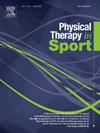长期髋关节和腹股沟疼痛患者的髋关节内收肌和外展肌力量与髋关节相关患者报告结果之间的关联:一项探索性横断面研究
IF 2.2
3区 医学
Q1 REHABILITATION
引用次数: 0
摘要
研究目的本研究旨在评估长期髋部和腹股沟疼痛(LHGP)患者的髋部肌力与髋部相关患者报告结果指标(PROMs)之间的关联:设计:横断面设计:参与者:81 名长期髋关节和腹股沟疼痛(LHGP)患者主要结果测量:主要结果测量:测量内收和外展时的髋部肌肉力量。哥本哈根髋关节和腹股沟结果评分(HAGOS)包括六个分量表(症状、疼痛、日常生活活动(ADL)、运动和娱乐中的身体功能(Sport/Rec)、参与体育活动(PA)和生活质量(QoL))。线性回归检验了髋部肌肉力量与 HAGOS 各分量表之间的关联:内收时髋部等长肌力越大,疼痛和日常活动能力的 HAGOS 评分越高(p ≤ 0.037),但症状、运动/康复、参与体育活动或生活质量的 HAGOS 评分不高(p ≥ 0.154)。伸展时髋关节等长肌力越大,症状、疼痛和 ADL 的 HAGOS 评分越高(p ≤ 0.034),但运动/康复、PA 或 QoL 的 HAGOS 评分不高(p ≥ 0.084):结论:在 LHGP 患者中,髋关节等长肌力越强,症状和疼痛越轻,ADL 功能越好。运动/康复、PA 或 QoL 均无相关性。本文章由计算机程序翻译,如有差异,请以英文原文为准。
The association between hip adductor and extensor strength, and hip-related patient-reported outcomes in patients with longstanding hip and groin pain: An exploratory cross-sectional study
Objective
The objective of this study was to assess the association between hip muscle strength and hip-related patient-reported outcome measures (PROMs) in patients with longstanding hip and groin pain (LHGP).
Design
Cross-sectional design.
Setting
Orthopedic care.
Participants
Eighty-one patients with LHGP were consecutively recruited.
Main outcome measures
Hip muscle strength was measured in adduction and extension. Hip-related PROMs was measured with the Copenhagen Hip and Groin Outcome Score (HAGOS) which includes six subscales (Symptoms, Pain, Activity in Daily Living (ADL), Physical Function in Sports and Recreation (Sport/Rec), Participation in Physical Activities (PA), and Quality of Life (QoL). Linear regression examined the association between hip muscle strength and each HAGOS subscale.
Results
Greater isometric hip muscle strength in adduction was associated with better HAGOS score for Pain and ADL (p ≤ 0.037), but not for Symptoms, Sport/Rec, PA, or QoL (p ≥ 0.154). Greater isometric hip muscle strength in extension was associated with better HAGOS score for Symptoms, Pain, and ADL (p ≤ 0.034), but not for Sport/Rec, PA, or QoL (p ≥ 0.084).
Conclusions
In patients with LHGP, greater isometric hip muscle strength seems to be associated with less symptoms and pain, and better function in ADL. No association was found for Sport/Rec, PA, or QoL.
求助全文
通过发布文献求助,成功后即可免费获取论文全文。
去求助
来源期刊

Physical Therapy in Sport
医学-康复医学
CiteScore
4.50
自引率
8.30%
发文量
125
审稿时长
39 days
期刊介绍:
Physical Therapy in Sport is an international peer-reviewed journal that provides a forum for the publication of research and clinical practice material relevant to the healthcare professions involved in sports and exercise medicine, and rehabilitation. The journal publishes material that is indispensable for day-to-day practice and continuing professional development. Physical Therapy in Sport covers topics dealing with the diagnosis, treatment, and prevention of injuries, as well as more general areas of sports and exercise medicine and related sports science.
The journal publishes original research, case studies, reviews, masterclasses, papers on clinical approaches, and book reviews, as well as occasional reports from conferences. Papers are double-blind peer-reviewed by our international advisory board and other international experts, and submissions from a broad range of disciplines are actively encouraged.
 求助内容:
求助内容: 应助结果提醒方式:
应助结果提醒方式:


